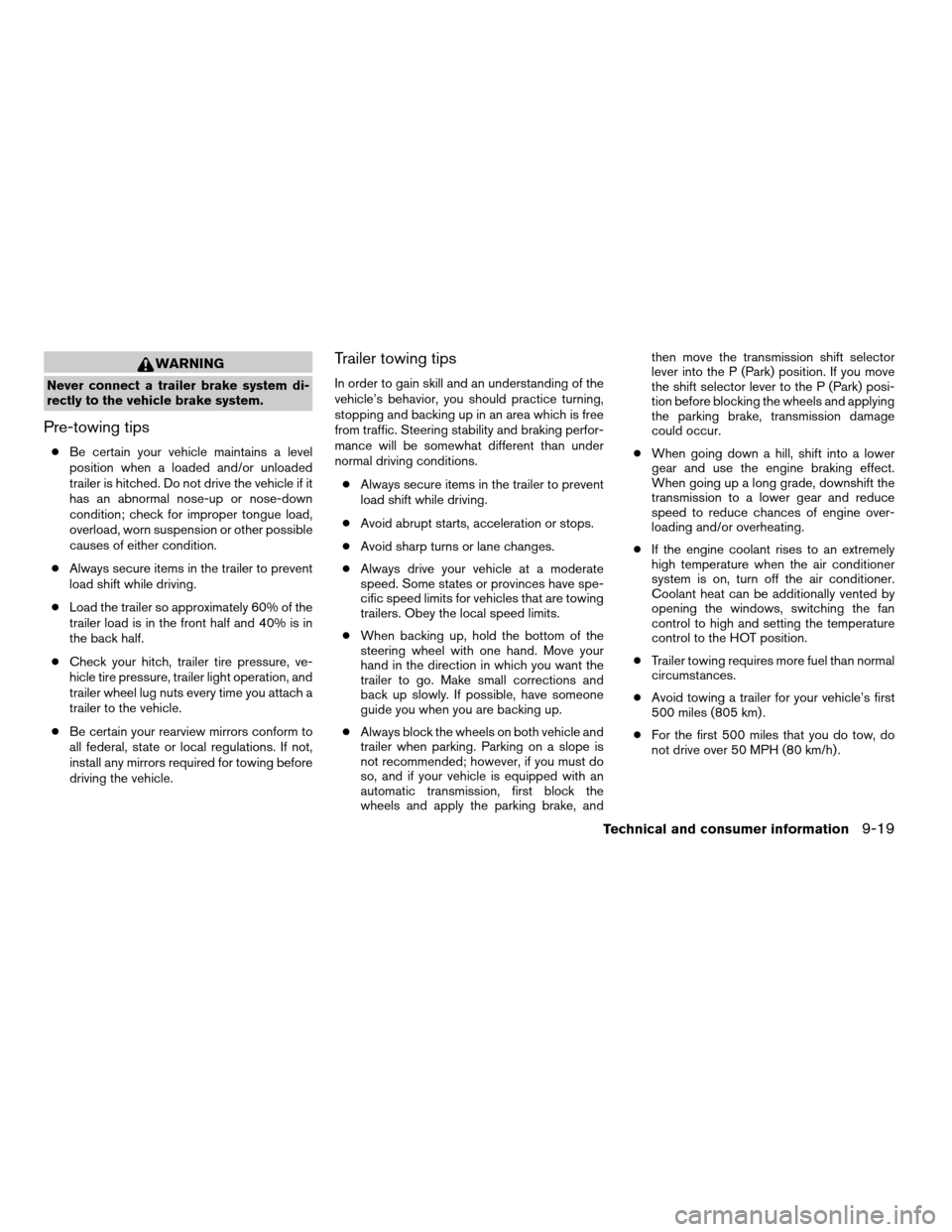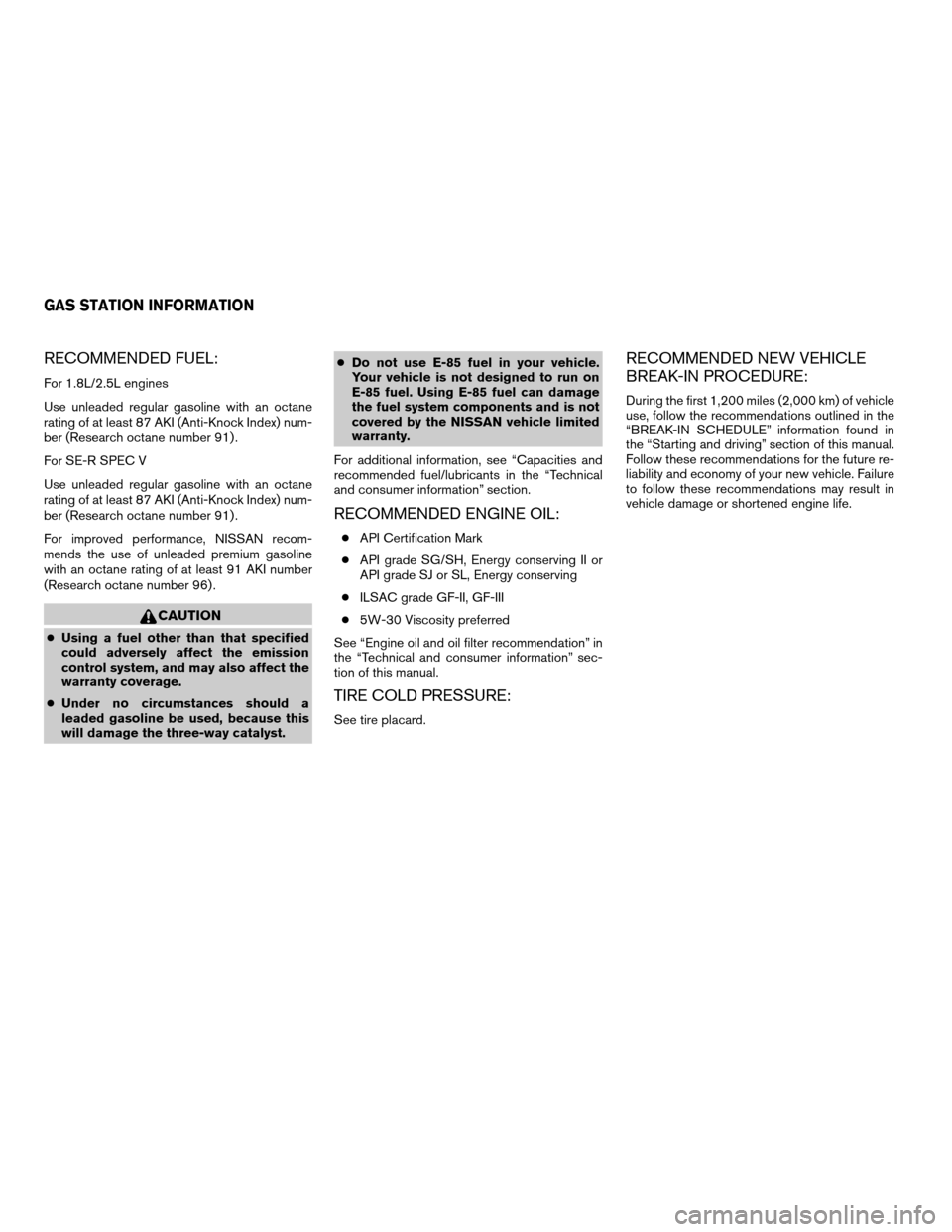2006 NISSAN SENTRA tire pressure
[x] Cancel search: tire pressurePage 235 of 256

WARNING
Never connect a trailer brake system di-
rectly to the vehicle brake system.
Pre-towing tips
cBe certain your vehicle maintains a level
position when a loaded and/or unloaded
trailer is hitched. Do not drive the vehicle if it
has an abnormal nose-up or nose-down
condition; check for improper tongue load,
overload, worn suspension or other possible
causes of either condition.
cAlways secure items in the trailer to prevent
load shift while driving.
cLoad the trailer so approximately 60% of the
trailer load is in the front half and 40% is in
the back half.
cCheck your hitch, trailer tire pressure, ve-
hicle tire pressure, trailer light operation, and
trailer wheel lug nuts every time you attach a
trailer to the vehicle.
cBe certain your rearview mirrors conform to
all federal, state or local regulations. If not,
install any mirrors required for towing before
driving the vehicle.
Trailer towing tips
In order to gain skill and an understanding of the
vehicle’s behavior, you should practice turning,
stopping and backing up in an area which is free
from traffic. Steering stability and braking perfor-
mance will be somewhat different than under
normal driving conditions.
cAlways secure items in the trailer to prevent
load shift while driving.
cAvoid abrupt starts, acceleration or stops.
cAvoid sharp turns or lane changes.
cAlways drive your vehicle at a moderate
speed. Some states or provinces have spe-
cific speed limits for vehicles that are towing
trailers. Obey the local speed limits.
cWhen backing up, hold the bottom of the
steering wheel with one hand. Move your
hand in the direction in which you want the
trailer to go. Make small corrections and
back up slowly. If possible, have someone
guide you when you are backing up.
cAlways block the wheels on both vehicle and
trailer when parking. Parking on a slope is
not recommended; however, if you must do
so, and if your vehicle is equipped with an
automatic transmission, first block the
wheels and apply the parking brake, andthen move the transmission shift selector
lever into the P (Park) position. If you move
the shift selector lever to the P (Park) posi-
tion before blocking the wheels and applying
the parking brake, transmission damage
could occur.
cWhen going down a hill, shift into a lower
gear and use the engine braking effect.
When going up a long grade, downshift the
transmission to a lower gear and reduce
speed to reduce chances of engine over-
loading and/or overheating.
cIf the engine coolant rises to an extremely
high temperature when the air conditioner
system is on, turn off the air conditioner.
Coolant heat can be additionally vented by
opening the windows, switching the fan
control to high and setting the temperature
control to the HOT position.
cTrailer towing requires more fuel than normal
circumstances.
cAvoid towing a trailer for your vehicle’s first
500 miles (805 km) .
cFor the first 500 miles that you do tow, do
not drive over 50 MPH (80 km/h) .
Technical and consumer information9-19
ZREVIEW COPYÐ2006 Sentra(b15)
Owners ManualÐUSA_English(nna)
09/01/05Ðdebbie
X
Page 240 of 256

Your vehicle is equipped with a variety of comput-
ers that monitor and control a number of systems
to optimize performance and help service techni-
cians with diagnosis and repair. Depending on
the equipment on your vehicle, some of the com-
puters monitor emission control systems, braking
systems, engine systems, transmission systems,
tire pressure systems, and airbag systems. Some
data about vehicle operation may be stored in the
computers for use during servicing. Other data
may be stored if a crash event occurs. For ex-
ample, air bag readiness, air bag performance,
and seat belt use by the driver or passenger may
be recorded, depending on vehicle equipment.
These types of systems are sometimes called
Event Data Recorders.
Special equipment can be used to access the
electronic data that may be stored in the vehicle’s
computers (sounds are not recorded) . NISSAN
and NISSAN dealers have equipment to access
some of this data; others may also have this
equipment. The data may be retrieved during
routine vehicle servicing or for special research. It
might also be accessed with the consent of the
vehicle owner or lessee, in response to a request
by law enforcement, or as otherwise required or
permitted by law.A genuine NISSAN Service Manual is the best
source of service and repair information for your
vehicle. Filled with wiring diagrams, illustrations
and step-by-step diagnostic and adjustment pro-
cedures, this manual is the same one used by the
factory-trained technicians working at NISSAN
dealerships. Also available are genuine NISSAN
Owner’s Manuals, and genuine NISSAN Service
and Owner’s Manuals for older NISSAN models.
For USA
For current pricing and availability of genuine
NISSAN Service Manualsfor the 2000 model
year and later contact:
Tweddle Litho Company
1-800-450-9491
www.nissan-techinfo.com
For current pricing and availability of genuine
NISSAN Service Manualsfor the 1999 model
year and prior, see a NISSAN dealer, or contact:
Resolve Corporation
20770 Westwood Road
Strongsville, OH 44136
1-800-247-5321For current pricing and availability of genuine
NISSAN Owner’s Manualsfor this model year
and prior, see a NISSAN dealer, or contact:
Resolve Corporation
20770 Westwood Road
Strongsville, OH 44136
1-800-247-5321
For Canada
To purchase a copy of a genuine NISSAN Ser-
vice Manual or Owner’s Manual please contact
your nearest NISSAN dealer. For the phone num-
ber and location of a NISSAN dealer in your area
call the NISSAN Information Center at 1-800-
387-0122 and a bilingual NISSAN representa-
tive will assist you.
Also available are genuine NISSAN Service and
Owner’s Manuals for older NISSAN models.
IN THE EVENT OF A COLLISION
Unfortunately, accidents do occur. In this unlikely
event, there is some important information you
should know.
Many insurance companies routinely authorize
the use of non-genuine collision parts in order to
cut costs, among other reasons.
EVENT DATA RECORDERS OWNER’S MANUAL/SERVICE
MANUAL ORDER INFORMATION
9-24Technical and consumer information
ZREVIEW COPYÐ2006 Sentra(b15)
Owners ManualÐUSA_English(nna)
09/01/05Ðdebbie
X
Page 244 of 256

Engine coolant temperature gauge.....2-7
Corrosion protection...............7-5
Cruise control..................5-14
Cup holders...................2-23
D
Daytime running light system
(Canada only)..................2-19
Defogger switch
Rear window defogger switch.......2-17
Dimmer switch for instrument panel......2-19
Door locks....................3-3
Door open warning light............2-10
Drive belts....................8-21
Driving
Cold weather driving............5-20
Driving with automatic transmission.....5-7
Driving with manual transmission.....5-11
Precautions when starting and driving . . .5-2
E
Economy - fuel.................5-16
Emission control information label.......9-11
Emission control system warranty.......9-22
Engine
Before starting the engine..........5-6
Capacities and recommended
fuel/lubricants.................9-2
Changing engine coolant..........8-9
Changing engine oil............8-12
Changing engine oil filter..........8-13
Checking engine coolant level........8-8Checking engine oil level..........8-11
Engine compartment check locations. . . .8-8
Engine coolant temperature gauge.....2-7
Engine cooling system............8-8
Engine oil..................8-11
Engine oil and oil filter recommendation . .9-5
Engine oil pressure warning light.....2-10
Engine oil viscosity..............9-5
Engine serial number............9-10
Starting the engine..............5-6
Event data recorders..............9-24
Exhaust gas (Carbon monoxide)........5-2
F
Flashers
(See hazard warning flasher switch)......2-20
Flat tire......................6-2
Floor mat positioning aid.............7-5
Fluid
Automatic transmission fluid (ATF). . . .8-14
Brake fluid..................8-17
Capacities and recommended
fuel/lubricants.................9-2
Clutch fluid.................8-18
Engine coolant................8-8
Engine oil..................8-11
Power steering fluid.............8-17
Window washer fluid............8-18
F.M.V.S.S. certification label..........9-10
Fog light switch.................2-20
Folding rear seat.................1-4
Front seats....................1-2Fuel
Capacities and recommended
fuel/lubricants.................9-2
Fuel economy................5-16
Fuel gauge..................2-8
Fuel octane rating..............9-4
Fuel recommendation............9-3
Fuel-filler door and cap...........3-12
Fuel-filler door lock opener lever......3-12
Fuses......................8-29
Fusible links...................8-29
G
Gascap.....................3-12
Gauge
Engine coolant temperature gauge.....2-7
Fuel gauge..................2-8
Odometer...................2-5
Speedometer.................2-4
Tachometer..................2-6
Trip computer.................2-5
Trip odometer.................2-5
General maintenance..............8-2
Glove box....................2-24
H
Hazard warning flasher switch.........2-20
Head restraints..................1-5
Headlight aiming adjustment..........8-34
Headlight and turn signal switch........2-18
Headlight control switch............2-18
Headlights....................8-33
10-2
ZREVIEW COPYÐ2006 Sentra(b15)
Owners ManualÐUSA_English(nna)
09/01/05Ðdebbie
X
Page 247 of 256

Shoulder belt height adjustment........1-13
Spark plug replacement............8-22
Speedometer...................2-4
Spotlights (See map light)...........2-30
SRS warning label...............1-41
Starting
Before starting the engine..........5-6
Jump starting.................6-7
Precautions when starting and driving . . .5-2
Push starting.................6-9
Starting the engine..............5-6
Steering
Power steering fluid.............8-17
Power steering system...........5-18
Tilting steering wheel............3-13
Stop light....................8-35
Storage.....................2-22
Storage tray...................2-25
Sunglasses case................2-22
Sunroof.....................2-28
Supplemental air bag warning light . . .1-42, 2-11
Supplemental restraint system
Precautions on supplemental restraint
system....................1-31
Supplemental restraint system
(Supplemental air bag system).........1-31
Switch
Automatic power window switch.....2-27
Fog light switch...............2-20
Hazard warning flasher switch.......2-20
Headlight and turn signal switch......2-18
Headlight control switch..........2-18
Ignition switch................5-4
Overdrive switch..............5-10
Power door lock switch...........3-4
Rear window defogger switch.......2-17Turn signal switch..............2-19
Windshield wiper and washer switch . . .2-16
T
Tachometer....................2-6
Temperature gauge
Engine coolant temperature gauge.....2-7
Theft (NISSAN vehicle immobilizer system) ,
engine start..............2-15, 3-2, 5-5
Three-way catalyst................5-2
Tilting steering wheel..............3-13
Tire
Flat tire....................6-2
Spare tire................6-3, 8-47
Tire chains..................8-45
Tire placard.................9-11
Tire pressure................8-39
Tire rotation.................8-45
Types of tires................8-44
Uniform tire quality grading.........9-21
Wheels and tires..............8-39
Top tether strap child restraint.........1-23
Towing
Flat towing..................9-20
Tow truck towing..............6-11
Trailer towing................9-16
Transmission
Automatic transmission fluid (ATF). . . .8-14
Driving with automatic transmission.....5-7
Driving with manual transmission.....5-11
Selector lever lock release.........5-10
Travel (See registering your vehicle in another
country)......................9-9
Trip computer...................2-5Trip odometer...................2-5
Trunk access through the rear seat.......1-4
Trunk lid lock opener lever............3-9
Trunk light....................2-30
Turn signal switch................2-19
U
Uniform tire quality grading...........9-21
V
Vanity mirror...................3-14
Vehicle identification...............9-9
Vehicle identification number (VIN)
(Chassis number).................9-9
Vehicle identification number (VIN) plate. . . .9-9
Vehicle loading information...........9-12
Vehicle recovery.................6-12
Vehicle security system.............2-13
Vehicle security system
(NISSAN vehicle immobilizer system) ,
engine start..............2-15, 3-2, 5-5
Ventilators.....................4-2
W
Warning
Air bag warning light.........1-42, 2-11
Anti-lock brake warning light........2-9
Battery charge warning light........2-10
Brake warning light..............2-9
Door open warning light..........2-10
10-5
ZREVIEW COPYÐ2006 Sentra(b15)
Owners ManualÐUSA_English(nna)
09/01/05Ðdebbie
X
Page 248 of 256

Engine oil pressure warning light.....2-10
Hazard warning flasher switch.......2-20
Low fuel warning light...........2-10
Low washer fluid warning light.......2-10
Seat belt warning light...........2-10
Vehicle security system...........2-13
Warning labels (for SRS)..........1-41
Warning/indicator lights and audible
reminders...................2-9
Warning lights..................2-9
Washer switch
Windshield wiper and washer switch . . .2-16
Wheels and tires................8-39
When traveling or registering your vehicle in
another country..................9-9
Window washer fluid..............8-18
Windows
Locking passengers’ windows.......2-27
Manual windows..............2-27
Power rear windows............2-27
Power windows...............2-25
Rear power windows............2-27
Windshield wiper and washer switch.....2-16
Wiper
Windshield wiper and washer switch . . .2-16
Wiper blades................8-26
10-6
ZREVIEW COPYÐ2006 Sentra(b15)
Owners ManualÐUSA_English(nna)
09/01/05Ðdebbie
X
Page 255 of 256

RECOMMENDED FUEL:
For 1.8L/2.5L engines
Use unleaded regular gasoline with an octane
rating of at least 87 AKI (Anti-Knock Index) num-
ber (Research octane number 91) .
For SE-R SPEC V
Use unleaded regular gasoline with an octane
rating of at least 87 AKI (Anti-Knock Index) num-
ber (Research octane number 91) .
For improved performance, NISSAN recom-
mends the use of unleaded premium gasoline
with an octane rating of at least 91 AKI number
(Research octane number 96) .
CAUTION
cUsing a fuel other than that specified
could adversely affect the emission
control system, and may also affect the
warranty coverage.
cUnder no circumstances should a
leaded gasoline be used, because this
will damage the three-way catalyst.cDo not use E-85 fuel in your vehicle.
Your vehicle is not designed to run on
E-85 fuel. Using E-85 fuel can damage
the fuel system components and is not
covered by the NISSAN vehicle limited
warranty.
For additional information, see “Capacities and
recommended fuel/lubricants in the “Technical
and consumer information” section.
RECOMMENDED ENGINE OIL:
cAPI Certification Mark
cAPI grade SG/SH, Energy conserving II or
API grade SJ or SL, Energy conserving
cILSAC grade GF-II, GF-III
c5W-30 Viscosity preferred
See “Engine oil and oil filter recommendation” in
the “Technical and consumer information” sec-
tion of this manual.
TIRE COLD PRESSURE:
See tire placard.
RECOMMENDED NEW VEHICLE
BREAK-IN PROCEDURE:
During the first 1,200 miles (2,000 km) of vehicle
use, follow the recommendations outlined in the
“BREAK-IN SCHEDULE” information found in
the “Starting and driving” section of this manual.
Follow these recommendations for the future re-
liability and economy of your new vehicle. Failure
to follow these recommendations may result in
vehicle damage or shortened engine life.
GAS STATION INFORMATION
ZREVIEW COPYÐ2006 Sentra(b15)
Owners ManualÐUSA_English(nna)
09/01/05Ðdebbie
X